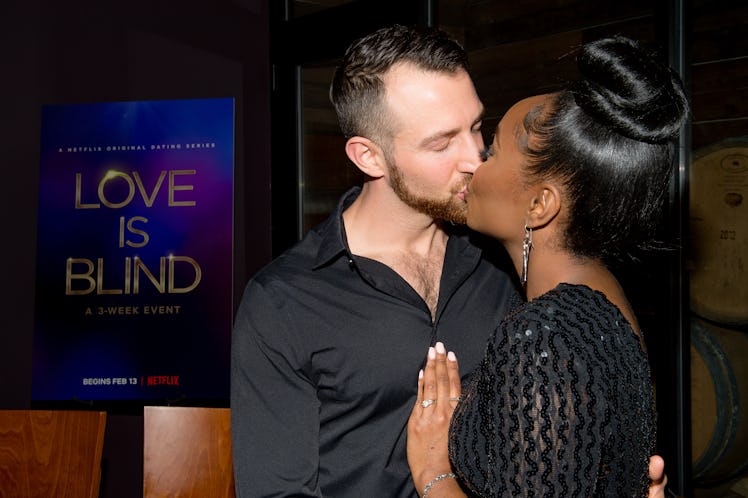
These Behind-The-Scenes Facts About 'Love Is Blind' Will Blow Your Mind
Watching Netflix's hit dating series, Love Is Blind, has been a total whirlwind. With so many snap engagements, brides (and grooms) left at the altar, and ultra cringeworthy parents-meeting-fiancé moments to digest, fans could maybe use a pod of their own to hibernate in until next season. Love Is Blind asked a lot of its contestants and its structure was a little confusing. How does the show really work? How much time did the couples even spend together in those pods? Why is everyone on the show from Atlanta? To answer all of your nagging questions ahead of the cast reunion special, here are 5 behind-the-scenes facts about Love Is Blind that will definitely blow your mind.
As of March 2020, filming for Love Is Blind Season 1 took place nearly 1.5 years ago, so these newlyweds have been keeping the show’s secrets for some time. Somehow, the Love Is Blind matches managed to stay tight-lipped, but with the cast reunion special premiering on Netflix March 4, a few of these trade secrets have started to emerge. From details about filming to what life was really like in the pods, fans of the show are about to have their minds blown.
1. Filming only took place for two months.
The whole process took approximately two months: 10 days in the pods and 15 days before the matches were allowed to return to the "real world." By the time each pair got their phones back were allowed to let their family in on the big news they had only known each other for about two weeks.
"It was about 15-16 days that we didn't talk to anybody in the outside world," Mark Cuevas described the experience on 11Alive. "So what was cool about that was we literally had to go into ourselves [and ask] what do I want, what's important to me?"
2. There were no guidelines for what couples could ask each other in the pods.
In a move that should surprise many Love Is Blind fans, producers never gave the couples any rules regarding what they were allowed to ask each other. Technically, the show could have fallen apart had contestants decided to ask a few more pointed questions. Luckily for producers, nobody intentionally tried to sabotage "the experiment."
3. The design of the pods was a major part of the show's initial pitch.
From set design to camera placement, the pods were designed to facilitate a connection between two people who couldn't see each other. Stakes were high – if the pods didn't work, there wouldn't be a show.
Paria Sadighi, SVP of the production company that came to Netflix with the design for the pods, told Refinery29 about the intricacies that went into their construction. "The comforting and soothing colors of the pods were all by design to allow our participants the best chance to really focus on the voice on the other side of the wall," she explained, "Even the acoustics of the pods were made to help the other senses relax into the octave of conversations."
4. Contestants weren't exactly living a life of luxury.
There's a reason why producers didn't showcase the living quarters during "the experiment." "We slept in trailers and they were correctional facility beds." Kenny told Refinery29. "The design was to just strip us down from our comfort level."
Sorry, guys. At least you got to spend a week in paradise.
5. All of the couples already lived in Atlanta.
In Episode 6, the couples were not traveling cross country to grab an overnight bag before moving in together. All of the contestants actually live relatively close to one another, and were cast for that very reason.
Show creator Chris Coelen explained to Entertainment Tonight: “The reason that we did that was because we wanted to give these people a real shot at making their relationships work for the long term,”
So if you're looking to get cast on Season 2, get ready for a move to the New York, Boston, or Houston areas, since Coelen has suggested producers are eager to cast there next.
This article was originally published on